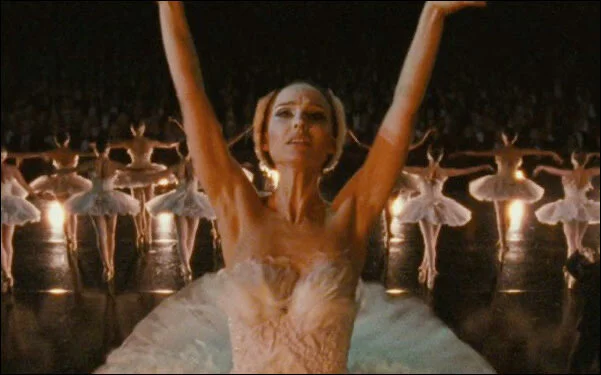Sad Girls Lens: Black Swan
in this column, Sad Girls Lens I aim to draw parallels between our blog themes and the intersections of mental health, femme identities, and film.
image via google.
by Abygai Peña.
Work better, faster, harder, stronger. January is a month filled with new year's resolutions designed to prey on our insecurities. When you’re a woman, the world makes sure you’re well aware of how you measure up (or don’t). In this column, Sad Girls Lens I aim to draw parallels between our blog themes and the intersections of mental health, femme identities, and film. This month’s theme (un)manifest destiny spoke to me and it said, “take a breath.” Sadly, the rest of the world is not likely to be on our sad girl level of enlightenment. While I expect that the rest of the world is on the fast track to perfection who can compare to Nina Sayers (Natalie Portman) in Black Swan (2010). Sayers, a New York City ballerina knows practice makes perfect. Yet as Sayers anticipates a role as the Queen Swan in her companies production of Swan Lake she’s told by her director that she is too frigid and too controlled. This is his misogynistic way of expressing his doubts in Nina’s ability to succeed given the duality of the swan queen.
Ballet director Thomas Leroy holds the perspective we see Nina from, he views her as pure, tense white swan who much release and submit into her role as the seductive black swan. The demand for perfection runs rampant for ballerinas. According to ballet psychologist Nadine Kaslow "The world of ballet is intensely competitive," she said. "They over-exercise and eat very little. Anorexia and bulimia are extremely common." Anorexia, bulimia, and OCD make a debut in the film. Nina is seen eating very little. She is even shown looking at half a grapefruit with wide eyes. The rest of her days include scenes where Nina is methodically lining up her stolen makeup in her prep room and frequently washing her hands. Nina is shown washing her hands with such rigor and intensity. These private moments with her reveal skin picking, scratching, and cutting that are difficult to stomach. Alongside the various eating disorders and anxiety Black Swan (2010) is about a ballerina’s descent into madness through various hallucinations and delusions. Nina begins having visual hallucinations early on in the film projecting her own face on a dark figure walking passed her on the way to the train. Throughout the film, it is unclear whether or not Nina actually rips pieces of skin starting at her fingertips. Arronofsky’s portrayal of a hyper-aware and self-conscious young woman who is losing touch with reality not only impossible but, problematic and telling of how high achieving women are constructed by the male gaze. Clinical psychologist and anxiety disorder specialist Jonathan Abramowitz tells ABC News, "It would be fairly rare to have a psychosis and an eating disorder," he said. "People in psychosis are not in touch with reality. With eating disorders and OCD, they are too in touch with reality."
The male gaze in the Black Swan (2010) is the point of view represented by Thomas Leroy the director of the ballet company. Thomas looks at Nina and only sees what he believes she lacks to become the swan queen. For him, she lacks wildness and sexuality. Yet, Thomas makes advances on Nina only to degrade and compare her to Lily (Mila Kunis). In reality, Nina has been working her whole life to become the lead/prima ballerina and her ambition is viewed as fridged. Countless characters tell Nina to relax. In this story, the sexy Lily is glorified but, not enough to be the swan queen just her alternate. No woman can win… in this movie. Although we can draw connections between these trope of women that have been constructed by men and understand how they have informed society’s expectation of women. The swan queen is a character with two sides, an evil doppelganger who is the black swan and a pure, white swan. Whether or not this was the intention of director Darren Arronofsky, his film utilizes a duality known as the Madonna–whore complex which is defined by a man's inability to integrate both sides that can exist within women like the ability to be nurturing and feel desire.
The Black Swan (2010) tells a story about how men see women descent into madness. Funny enough the madness is caused by a patriarchal expectation of their bodies, sexuality, and even their mannerisms and personality. Nina self is constructed by the projections of those around her. Infantilized by her mother, rejected, sexualized, and degraded by Thomas. Nina can’t win. Even at the end of the film when she gives an integrated performance of both swans the stress of expectations causes her to scab herself with a shard of glass and slip away, losing blood as she loses herself in her role as the swan queen.
***
Abygai Peña is a Manhattan-bound feminist filmmaker and writer who contributes to BUST Magazine and Sad Girls Club while serving at the Deputy Editor of arthouse film magazine Cinema Skyline and Managing Newsletter Editor of Bluestockings Bookstore. Abygai Peña’s work lives at the intersections of cinema, gender, activism, and the occult. Abygai Peña is utilizing her expertise to soon launch a new publication called Banshe Magazine which aims to deconstruct and decolonize femme images in media.

